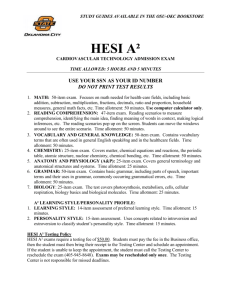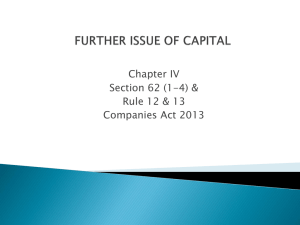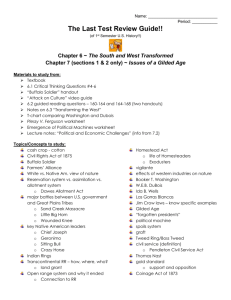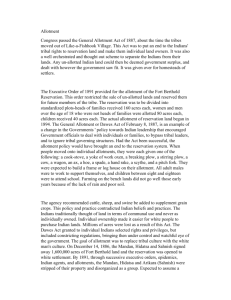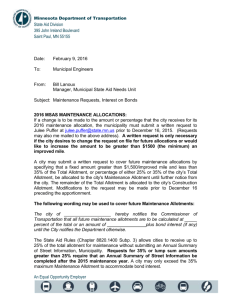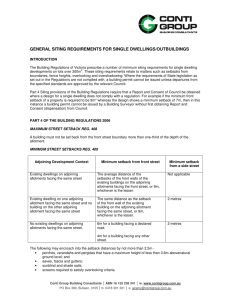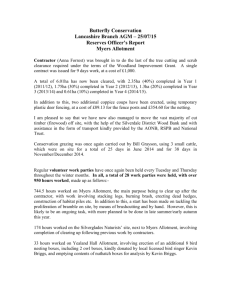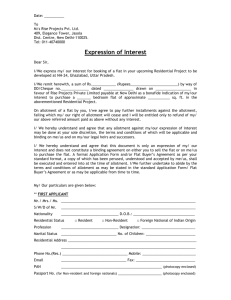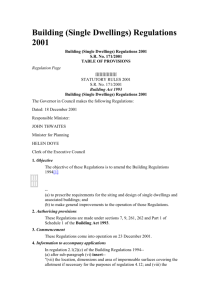Rescode Guidelines - TJ Building Consultants
advertisement
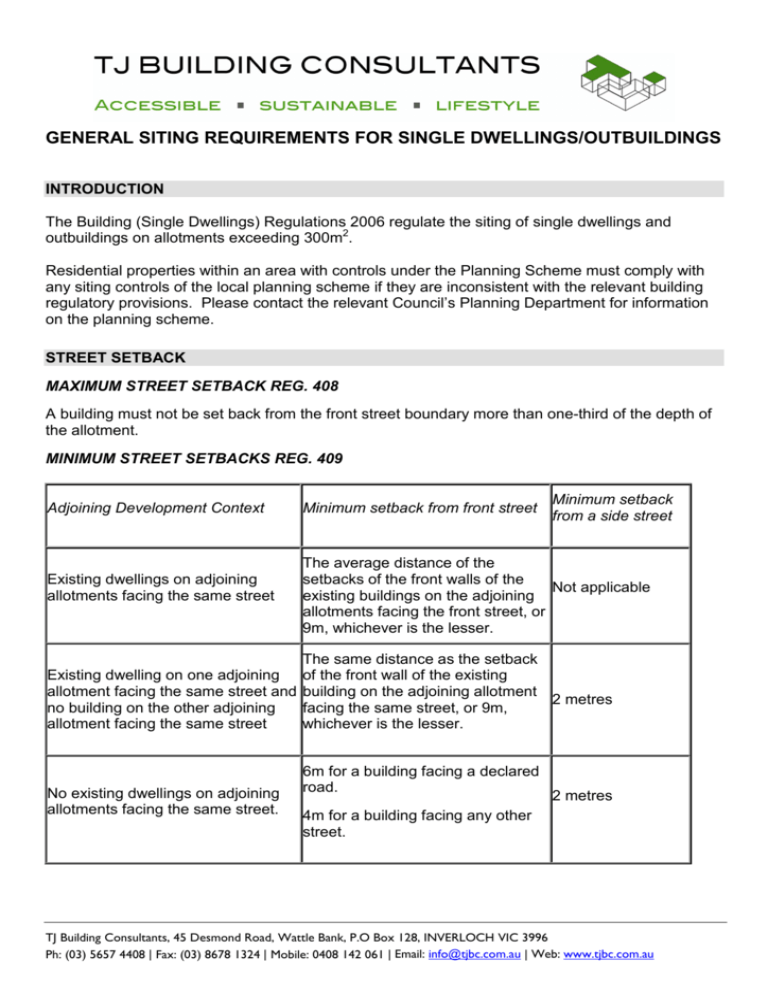
GENERAL SITING REQUIREMENTS FOR SINGLE DWELLINGS/OUTBUILDINGS INTRODUCTION The Building (Single Dwellings) Regulations 2006 regulate the siting of single dwellings and outbuildings on allotments exceeding 300m2. Residential properties within an area with controls under the Planning Scheme must comply with any siting controls of the local planning scheme if they are inconsistent with the relevant building regulatory provisions. Please contact the relevant Council’s Planning Department for information on the planning scheme. STREET SETBACK MAXIMUM STREET SETBACK REG. 408 A building must not be set back from the front street boundary more than one-third of the depth of the allotment. MINIMUM STREET SETBACKS REG. 409 Adjoining Development Context Existing dwellings on adjoining allotments facing the same street Minimum setback from front street Minimum setback from a side street The average distance of the setbacks of the front walls of the Not applicable existing buildings on the adjoining allotments facing the front street, or 9m, whichever is the lesser. The same distance as the setback Existing dwelling on one adjoining of the front wall of the existing allotment facing the same street and building on the adjoining allotment 2 metres no building on the other adjoining facing the same street, or 9m, allotment facing the same street whichever is the lesser. No existing dwellings on adjoining allotments facing the same street. 6m for a building facing a declared road. 2 metres 4m for a building facing any other street. TJ Building Consultants, 45 Desmond Road, Wattle Bank, P.O Box 128, INVERLOCH VIC 3996 Ph: (03) 5657 4408 | Fax: (03) 8678 1324 | Mobile: 0408 142 061 | Email: info@tjbc.com.au | Web: www.tjbc.com.au 2 The following may encroach into the setback distances by not more than 2·5m • porches, verandahs and pergolas that have a maximum height of less than 3·6m above natural ground level; and • eaves, fascia and gutters; • sunblind and shade sails; • screens required to satisfy overlooking criteria. "Declared road" means a declared road within the meaning of the Transport Act 1983. BUILDING HEIGHT REG. 410 The height of a building must not exceed • 10m if the slope of the natural ground level at any cross section wider than 8m of the site of the building is 2.5° or more; or • 9m in any other case. SITE COVERAGE REG. 411 Buildings must not occupy more than 60% of an allotment. Unroofed swimming pools, unroofed terraces and eaves may be disregarded for the purposes of calculating site coverage. PERMEABILITY REG. 412 If a building is to be constructed on an allotment, not more than 80% of the area of the allotment can be covered by impermeable surfaces. CAR PARKING REG. 413 If a new Class 1 building is to be constructed on an allotment, provision must be made for 2 car parking spaces on the allotment. Of the 2 car parking spaces • one space must be at least 6m long and 3·5m wide; and • the second space must be at least 4·9m long and 2·6m wide. • if the 2 required car parking spaces adjoin each other in a garage or carport or in a space constrained by walls, the double space may be 5·5m in width. An alteration to a building on an allotment must not reduce the number of car parking spaces on the allotment unless there are more than 2 in which case the number may be reduced to 2. A building may project into a car parking space if it is at least 2·1m above that space. TJ Building Consultants, 45 Desmond Road, Wattle Bank, P.O Box 128, INVERLOCH VIC 3996 Ph: (03) 5657 4408 | Fax: (03) 8678 1324 | Mobile: 0408 142 061 | Email: info@tjbc.com.au | Web: www.tjbc.com.au 3 SIDE AND REAR SETBACKS REG. 414 Building height at any point Minimum setback from side or rear boundary at that point 3·6m or less 1m More than 3·6m but not more –than 6·9m. 1m plus an additional distance calculated at the rate of 300mm for every metre of height over 3·6m. More than 6.9m. 2m plus an additional distance calculated at the rate of 1m for every metre of height over 6·9m. The following may encroach into the setback distance by not more than 500mm • • • • • • • porches and verandahs; masonry chimneys; sun blinds; screens referred to in Regulation 4.19(4) or 4.19(5); flues and pipes; domestic fuel tanks and water tanks; heating and cooling equipment and other services. The following may encroach into the setback distance • • • • • • eaves, fascia and gutters 600mm in total width; landings with an area of not more than 2m2 and less than 1m high; unroofed stairways and ramps; pergolas; shade sails; carports (subject to regulation 4.15). 4.1m 1m 1m 2.1m 2.1m 9m 6.9m Lot boundary 3.6m max 3m av. TJ Building Consultants, 45 Desmond Road, Wattle Bank, P.O Box 128, INVERLOCH VIC 3996 Ph: (03) 5657 4408 | Fax: (03) 8678 1324 | Mobile: 0408 142 061 | Email: info@tjbc.com.au | Web: www.tjbc.com.au 4 WALLS ADJACENT TO BOUNDARIES REG. 415 This applies to the construction of • a wall on or within 150mm of a side or rear boundary of an allotment; • a carport constructed on or within 1m of a side or rear boundary of an allotment. The length of the wall, or of the carport, or of the wall and carport, must not, either by itself or when combined with the length of any existing wall or carport, be greater than the greater of • 10m plus 25% of the remaining length of the boundary of the allotment; or • the length of any existing wall or carport constructed on an adjoining allotment which is within 150mm of the boundary of that allotment. If the proposed construction abuts the existing wall or carport. A wall or carport constructed within 150mm of a side or rear boundary of an allotment must not exceed an average height of 3m and a maximum height of 3·6m along the boundary. If a wall or carport abuts an existing wall it may be constructed to the same height as that wall. DAYLIGHT TO EXISTING HABITABLE ROOM WINDOWS REG. 416 A building must be set back from a habitable room window in an existing building on an adjoining allotment to provide for a light court to the window that has a minimum area of 3m2 and a minimum dimension of 1m clear to the sky. The area of the required light court may include land on the adjoining allotment. A wall or carport with an average height of more than 3m opposite a habitable room window in an existing dwelling on an adjoining allotment must be set back from that window at least half the height of the wall or carport if the wall or carport is within a 55° angle in the horizontal plane abo ut a vertical axis through the centre of the window. The angle may be swung to not less than 35° from th e plane of the wall containing the window. If the window is above ground floor level, then for the purposes of that sub-regulation, the wall or carport height is to be measured from the floor level of the room containing the window. Existing proposed existing proposed a 550 The set back applies to a wall within a 550 arc from the centre of the window 550 The arc may be swung to within 350 of the plan of the wall containing the window 350 Wall set back from the window half the height of the wall Wall set back from the window half the height of the wall TJ Building Consultants, 45 Desmond Road, Wattle Bank, P.O Box 128, INVERLOCH VIC 3996 Ph: (03) 5657 4408 | Fax: (03) 8678 1324 | Mobile: 0408 142 061 | Email: info@tjbc.com.au | Web: www.tjbc.com.au 5 SOLAR ACCESS TO EXISTING NORTH FACING HABITABLE ROOM WINDOWS REG. 417 This applies if • a north-facing habitable room window of an existing dwelling on an adjoining allotment is within 3m of a boundary of the allotment on which the building is to be constructed; and • the window is orientated towards the boundary. The proposed building must be set back from the boundary not less than the distance specified in the following Table for a distance of 3m from the edge of each side of the window: Building height at any point Minimum setback from side or rear boundary at that point 3·6m or less 1m More than 3·6m but not more than 6·9m. 1m plus an additional distance calculated at the rate of 600mm for every metre of height over 3·6m. More than 6·9m. 3m plus an additional distance calculated at the rate of 1m for every metre of height over 6·9m. A north-facing window is a window with an axis perpendicular to its surface oriented north 20° west to north 30° east. OVERSHADOWING REG. 418 A building constructed on an allotment must not reduce the sunlight to a recreational private open space of an existing dwelling on an adjoining allotment to the extent that less than the required minimum area of the recreational private open space has less than 5 hours of sunlight between 9am and 3pm on 22 September. The amount of sunlight to that area must not be further reduced by the construction of any building if the recreational private open space is less than the required amount. In this regulation the required minimum area of a secluded private open space is the lesser of • 75% of the secluded private space; and • 40m2 with a minimum dimension of 3m. OVERLOOKING REG. 419 A habitable room window or raised open space of a building on an allotment must not provide a direct line of sight into a habitable room window or on to seclude private open space of an existing dwelling on an adjoining allotment within a horizontal distance of 9m (measured at ground level) of the window or raised open space. The direct line of sight must be measured within a 45° angle from the plane of the window or perimeter of the raised open space and from a height of 1·7m above the floor level of the habitable room or raised open space. TJ Building Consultants, 45 Desmond Road, Wattle Bank, P.O Box 128, INVERLOCH VIC 3996 Ph: (03) 5657 4408 | Fax: (03) 8678 1324 | Mobile: 0408 142 061 | Email: info@tjbc.com.au | Web: www.tjbc.com.au 6 A habitable room window complies if • it is offset a minimum of 1·5m from the edge of one window to the edge of the other; or • it has a sill height at least 1·7m above floor level; or • it has obscure glazing in any part of the window below 1·7m above floor level; or • it is obscured by a permanent and fixed screen which has no more than 25% of its area open. A raised open space complies if the direct line of sight into the habitable room window or secluded private open space on the adjoining allotment is obscured by a permanent and fixed screen which has no more than 25% of its area open. A window may be openable provided that when open the obscure glazing does not permit a direct line of sight into the secluded private open space or habitable room window. This does not apply to a new habitable room window that faces a property boundary if • there is a visual barrier at least 1·8m high at the boundary; and • the floor level of the room is less than 800mm above ground level at the boundary. Raised open space means • a landing with an area of more than 2m2 and with a floor height of 800mm or more above natural ground level at the boundary; or • a balcony, terrace, deck or patio with a floor height of 800mm or more above natural ground level at the boundary. Existing private open space Area to be screened or obscured 450 9m radius 450 9m radius New dwelling existing New dwelling DAYLIGHT TO NEW HABITABLE ROOM WINDOWS REG. 420 A habitable room window of a building on an allotment must face • an outdoor space clear to the sky, not including land on an adjoining allotment; or • a lightcourt with a minimum area of 3m2 and minimum dimension of 1m clear to the sky, not including land on an adjoining allotment; or (c) a verandah on the allotment if it is open for at least one third of its perimeter; or • a carport on the allotment if o it has 2 or more sides open; and o it is open for at least one third of its perimeter. TJ Building Consultants, 45 Desmond Road, Wattle Bank, P.O Box 128, INVERLOCH VIC 3996 Ph: (03) 5657 4408 | Fax: (03) 8678 1324 | Mobile: 0408 142 061 | Email: info@tjbc.com.au | Web: www.tjbc.com.au 7 A side of a carport or verandah may be taken to be open if the roof covering of the carport or verandah adjacent to that side is not less than 500mm from another building on the allotment or the adjoining allotment boundary. PRIVATE OPEN SPACE REG. 421 A Class 1 building on an allotment must have private open space of not less than 80m2 or 20% of the area of the allotment, whichever is the lesser. The private open space must include, an area at the side or rear of the building with • an area of at least 25m2 with a minimum dimension of 3m; and • convenient access from a habitable room (other than a bedroom). DEFINITIONS Private Open Space An unroofed area of land; or A Class 10b building associated with a Class 1 building. Recreational Private Open Space Any part of private open space which is primarily intended for outdoor recreational activities and is enclosed for 90% of it’s perimeter by walls, fences or other barriers at least 1.5m high above finished ground level. Clear to the sky An unroofed area or an area roofed with a material that transmits at least 90% of light. Height The vertical distance between the natural ground level at the base of the building / wall to the top of the roof covering (building) or to the underside of the roof covering at the point at which the outer wall intersects the plane of the roof covering (wall). How to Apply for a Dispensation An application for Consent and Report with respect to the Building Regulations siting requirements must contain the following: 1. An application form providing relevant details pertaining to the application and the Regulation for which Consent and Report is being applied for. 2. Details which clearly demonstrate in quantitative and qualitative terms compliance with the Objectives of the Building Regulations and Ministers Decision Guidelines. 3. Copy of Title and 3 sets of plans of the subject allotment, adjoining properties and where relevant the location of habitable room windows, private open space, secluded private open space relevant elevations and sections appropriately dimensioned. TJ Building Consultants, 45 Desmond Road, Wattle Bank, P.O Box 128, INVERLOCH VIC 3996 Ph: (03) 5657 4408 | Fax: (03) 8678 1324 | Mobile: 0408 142 061 | Email: info@tjbc.com.au | Web: www.tjbc.com.au 8 4. Owners of adjoining properties that may suffer detriment as a result of the proposal, will be contacted by Council, for written comments. 5. The Non-refundable fee of $200 is applicable for each application where 1 or more reporting matters have been ticked on the application form. Re-submissions will be viewed as a new application incurring this fee. Lack of information in relation to an application is likely to result in processing delays or refusal. NOTES: This information is provided in good faith. No responsibility is accepted for any errors or omissions. It is recommended that specific information be obtained immediately prior to the design process with respect to any building proposal to confirm compliance with the Building Regulations. Should you require any specific advice contact TJ Building Consultants TJ Building Consultants, 45 Desmond Road, Wattle Bank, P.O Box 128, INVERLOCH VIC 3996 Ph: (03) 5657 4408 | Fax: (03) 8678 1324 | Mobile: 0408 142 061 | Email: info@tjbc.com.au | Web: www.tjbc.com.au
